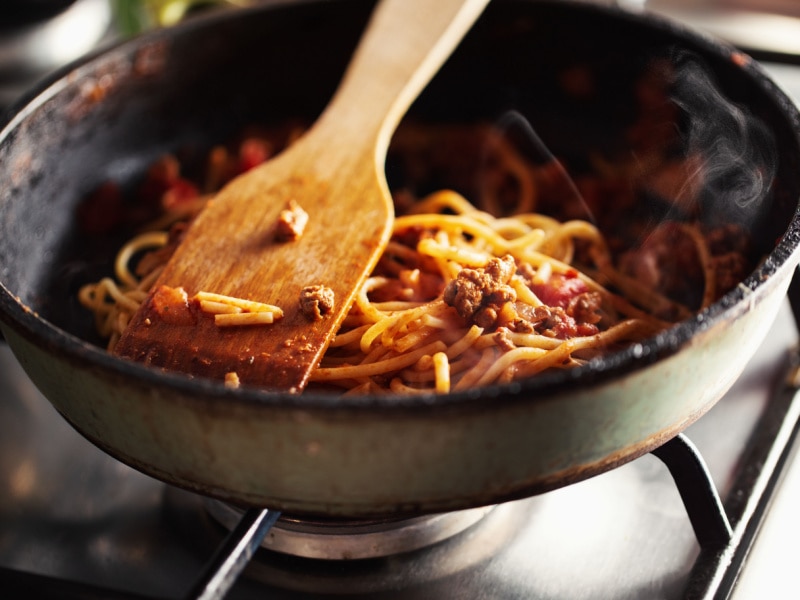Wondering how to reheat pasta? You certainly aren’t alone!
We’ve all had a sad bowl of leftovers once or twice. So let’s find the 4 best ways to reheat pasta!

Pasta on night one is a saucy masterpiece. But pasta on night two is often a dry, gluey mess.
The reason is simple: the fridge absorbs all that sauce and moisture. And a trip in the microwave makes matters even worse.
But from sauceless noodles and leftover mac and cheese to spaghetti and red sauce, these hacks work on them all!
With a few easy tricks, you can make those noodles as delicious as night one with this guide on how to reheat pasta.
How to Reheat Pasta
Leftover pasta is dry because the noodles absorb most of the liquid when they’re placed in the fridge.
So, adding extra moisture is key. And when I say “add moisture”, it doesn’t have to be water.
You can add anything from more scrummy pasta sauce and butter to cream or stock.
It’s a great way to expertly reheat those leftovers and make them tastier than night one!
As for the method, I almost always use the microwave.
It’s fast and easy. But you can use the stove or oven if you prefer.
Ready to dive a little deeper? Let’s get into it!

1. Place in Boiling Water
I like adding sauce to each serving when I whip up a pasta dish for dinner.
Placing sauceless pasta in the fridge makes the reheating process so easy.
Plus, it’s a great way to make a new dish the following night.
If you had pasta with marinara the night before, you could switch things up with a white sauce the next night.
1. Bring a pot of salted water to a rolling boil.
2. Add the cold pasta noodles, and boil for around 60 seconds.
3. Strain, add your sauce, and serve!
This method ensures they are nice and tender and won’t stick together.
Once they are nice and warm, strain the water and add your sauce.
This method results in perfectly tender noodles that are ready for sauce.
But if your noodles are already sauced, this method won’t work. For sauced noodles, check out the other options below.

2. Bake in the oven
The oven method transforms your leftovers into a new dish the following day.
The oven helps warm the noodles and creates a crispy crust without zapping moisture.
This method works wonderfully for things like mac and cheese, but it’s great for things like lasagna or spaghetti with marinara.
Since your noodles likely absorbed some sauce in the fridge, add extra sauce to ensure your dish is nice and creamy.
1. Preheat the oven to 350 degrees Fahrenheit
2. Place the noodles in an oven-safe dish, and cover it with foil.
3. Bake them for 15-20 minutes until heated through.
And to take those leftovers over the top, you can remove the foil during the last few minutes and sprinkle cheese on top.
They’re crispy and cheesy on the outside and so tender and saucy on the inside. Delicious!

3. Saute on the Stove
Sauteeing your noodles in a sautee pan works for plain and sauced noodles.
It’s quick, easy, and a great way to infuse leftovers with extra flavor.
1. Add olive oil to a sautee pan, and set the heat to low.
2. Add noodles to the pan, and stir frequently.
3. Cook under low heat for a few minutes until the noodles are warm.
You can even add some garlic or onions for a boost of flavor. Add noodles to the pan, and stir frequently.
Ensure you constantly stir your leftovers to prevent them from burning or overcooking.
No one wants burned mushy noodles!
While the noodles reheat, you can add seasoning like fresh herbs and spices to make them even more flavorful than the night before.
And a sprinkling of extra cheese like shredded Parmesan or mozzarella doesn’t hurt, either!

4. Microwave with Water
Yes, you can reheat those leftovers in the microwave with a few clever hacks.
The microwave loves to zap any remaining moisture in your noodles, so add extra water before popping it in the microwave.
Adding water or chicken stock helps the noodles stay nice and tender for sauceless noodles.
If you have sauced noodles, you can add extra sauce to keep them tender.
1. Place the noodles in a microwave-safe dish, add water, and loosely cover.
2. Cook them for 60 seconds, and stir.
3. Continue to cook the noodles for 15 seconds until they reach the desired temperature.
It’s essential to reheat them slowly using this method.
The longer they stay in the microwave, the more likely they will dry out. Patience is key.
There are better methods for reheating, but it’s undoubtedly the easiest and the fastest!
How Long Does Leftover Pasta Last?
The lifespan of cooked pasta depends upon the type of noodle used.
Boxed pasta will last for several days in the fridge, while fresh pasta lasts only 2 to 3 days.
When storing leftover pasta, there are a few things to remember to ensure that your pasta is safe to eat and ready to reheat.
Always place cooked pasta in the fridge within 2 hours of cooking.
Pasta left out for more than 4 hours is susceptible to bacteria that will make you sick.
And heating it won’t kill the bacteria. This type of bacteria is resistant to heat!
To keep your pasta fresh and safe from bacteria, place it in an air-tight container and store it in the fridge.
I like to place leftover pasta in a freezer bag because it helps me remove as much excess air as possible.
You can also freeze cooked pasta! Cooked pasta lasts up to 3 months in the freezer.
When ready to reheat, use one of the methods mentioned above. Easy peasy!










